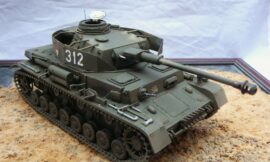The Jagdpanther was one of the formidable tank destroyers fielded by Germany during World War II, known for its powerful armament, heavy armor, and effective combat performance. Developed on the chassis of the Panther tank, the Jagdpanther combined the mobility and protection of the Panther with a potent anti-tank gun, making it a feared adversary on the battlefield.
Development and Design
The development of the Jagdpanther began in late 1943 in response to the success of the Soviet T-34 and KV tanks encountered on the Eastern Front. The goal was to create a tank destroyer that could effectively engage and destroy heavily armored enemy tanks from long distances. The chassis of the Panther tank was chosen due to its excellent mobility, reliability, and existing production capabilities.
The Jagdpanther featured a fixed superstructure housing the main armament, which eliminated the need for a turret and reduced the vehicle’s profile, making it harder to spot and target. The armor was sloped and well-sloped, providing excellent protection against most Allied anti-tank weapons. Frontal armor thickness was up to 80 mm, which provided good protection against most Allied tanks at the time.
Armament and Capabilities
The primary armament of the Jagdpanther was the formidable 8.8 cm Pak 43/3 L/71 anti-tank gun. This gun was a variant of the famous 8.8 cm Flak gun used in anti-aircraft roles but adapted for ground use. It had exceptional armor-piercing capabilities, with a high muzzle velocity that allowed it to effectively engage and penetrate Allied tanks at long ranges. The gun could fire armor-piercing shells capable of penetrating up to 203 mm of armor at 1,000 meters, making the Jagdpanther a formidable opponent on the battlefield.
Secondary armament included one or two 7.92 mm MG 34 or MG 42 machine guns for defense against infantry and light vehicles.
Mobility and Performance
The Jagdpanther was powered by a Maybach HL 230 P30 engine, which produced 700 horsepower. This engine, coupled with the Panther’s reliable torsion bar suspension system, provided the Jagdpanther with excellent mobility and cross-country performance. It had a top speed of around 46 km/h (28 mph) on roads and a range of approximately 160 kilometers (100 miles) on a full tank of fuel, which allowed it to maneuver effectively across various types of terrain.
Operational History
The Jagdpanther entered production in early 1944 and saw its first combat deployment later that year. It was used primarily on the Eastern and Western Fronts, where it proved to be highly effective against Allied armor. Its powerful gun and thick armor made it a preferred choice for engaging enemy tanks at long ranges, often in defensive and ambush roles. The Jagdpanther’s reliability and combat effectiveness earned it respect among German tank crews and fear among Allied tank commanders.
Despite its effectiveness, production of the Jagdpanther was limited by the deteriorating war situation for Germany, including shortages of materials and skilled labor. Approximately 392 Jagdpanthers were produced by the war’s end, with some remaining in service in the post-war era.
Legacy and Impact
The Jagdpanther is considered one of the best tank destroyers of World War II, praised for its firepower, armor protection, and mobility. Its design influenced post-war tank destroyer concepts, particularly in the emphasis on combining powerful anti-tank guns with heavy armor and good mobility. The lessons learned from the Jagdpanther’s development and deployment continue to inform armored vehicle design and tactics to this day.
Conclusion
The Jagdpanther, built on the proven chassis of the Panther tank and armed with the formidable 8.8 cm Pak 43/3 L/71 gun, was a formidable tank destroyer used by Germany during World War II. Its combination of firepower, armor protection, and mobility made it a highly effective adversary on the battlefield, capable of engaging and destroying Allied tanks at long ranges. Despite its limited production numbers, the Jagdpanther’s impact on armored warfare and its legacy as a formidable tank destroyer are widely recognized in military history.















